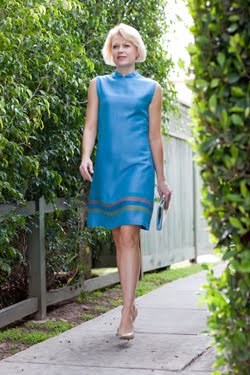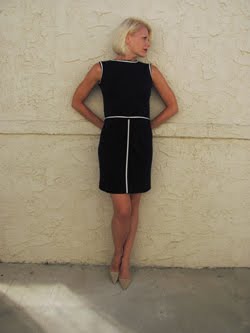Not long ago, I spent an evening presenting The Style Essentials: History of Fashion in Film 1920s-1930s at the Annenberg Beach House. The former beachfront estate of screen star Marion Davies, the venue could not have been more ideal to share my choices of the most iconic costume design in the movies that continues to influence fashion today. One of the films from this elite list is 1928's Our Dancing Daughters.
Our Dancing Daughters is one of those films that really reflected its moment in history. The 1920s were one long celebration after the great sacrifice and hardships of World War I. Women had won the right to vote at the beginning of the decade and with it came an empowerment and sense of newfound freedom. These were also the days of Prohibition, so there was an additional rebellious spirit in the air as an entire generation sought to find its identity. At the time Our Dancing Daughters was made, the Jazz Age was at the peak of prosperity and still more than a year before the financial crash that would cause the Great Depression. People really were dancing on table tops and celebrating the ongoing economic boom in the United States.
One of those doing the dancing was Joan Crawford. In fact, she was really good. While still known as Lucille LeSueur, she started her career as a dancer and used those skills to create a new life for herself...far away from an impoverished childhood that included a father who abandoned her at birth. She was discovered dancing in Detroit, which led to a show on Broadway and soon a screen test for MGM. Though she was signed to a contract in 1925 and rechristened 'Joan Crawford,' she was disenchanted with the small parts that came her way those first few years. As a result, this master of self-promotion decided to literally dance her way through every hot club in Hollywood to attract the attention of the studio bosses. It worked. That perseverance led to the role that would make her a star.
Our Dancing Daughters could not have been a better showcase for Joan and her talent. Made in the days before the censorship of the Hays Code (1930-1967), producers continued to push the limit of what was shown on screen. As a result, this silent movie feels anything but and its energy completely captures the zeitgeist of the times. Joan was a huge part of that...her dancing was front and center, and her free spirit and journey through the loosening morals of the 1920s made her seem the quintessential flapper. This included The Great Gatsby (1925) author F. Scott Fitzgerald who wrote,
Joan Crawford is doubtless the best example of the flapper, the girl you see in smart night clubs, gowned to the apex of sophistication, toying iced glasses with a remote, faintly bitter expression, dancing deliciously, laughing a great deal, with wide, hurt eyes. Young things with a talent for living.Clearly, the costumes and overall style of Our Dancing Daughters was a huge part of its success. The picture was produced by Hunt Stromberg, a man who knew something of the value of style and featured it prominently in movies such as The Thin Man (1934) and After the Thin Man (1936). Dancing's wardrobe was credited to David Cox, one of MGM's earliest costume designers but relatively unknown today. He studied, as many designers did, at the New York School of Fine & Applied Arts (now Parsons), and his career evolved from sketch artist to fashion designer on the East Coast. MGM came calling in 1928, and Our Dancing Daughters was an early film and great success for their newfound costume designer.
Yet Our Dancing Daughters should be remembered as a great success for Cox. Its style was the epitome of Art Deco glamour and immediately influenced fashion of the late 1920s. Each of the actresses--Joan, Anita Page, and Dorothy Sebastian--wear dress after dress dripping in sequins, beading, and fringe. Accessories like fur stoles and long necklaces are draped over the girls for their parties at night. The production and costume design completely captured the decadence of the age, so it's no wonder that Our Dancing Daughters has become the reference point for any production today that is set in the 1920s, such as Oscar winners The Artist (2011) and Baz Luhrmann's The Great Gatsby (2013).
Our Dancing Daughters also included groundbreaking menswear on each of its leading ladies. It's important to remember that this was still a time when women simply did not wear pants. This film made it seem very modern and opened the door for more women to try it in their own wardrobes. It helped start us on a path that would include Marlene Dietrich in Morocco (1930) and Katharine Hepburn in Woman of the Year (1942) through to Diane Keaton in Annie Hall (1977) and beyond. As you can see, Our Dancing Daughters is a quintessential example of late 1920s flapper style and easily one of The Style Essentials for its ongoing influence in both costume design and fashion.
Champagne and Joan in her showstopper of a quintessential 1920s flapper dress
complete with fringe and a deep draped back
This is the moment of a generation on film--
flapper Joan Crawford dancing on the tabletop
Diana has a rival for the affections of Ben in blonde Ann (Anita Page)...
...and a true friend in frequent confidant Beatrice (Dorothy Sebastian)
Besides the party attire, the casual side of the girls' clothes includes separates that are on trend today
as well as iconic menswear that would later influence others such as Annie Hall (1977)
Even accessories like their cloche hats are a huge inspiration from the time
































































































5 comments:
I love how you've tethered this to Annie Hall and the quality of the images make it so evident that Joan's hard work paid off. Loved this look at an over-looking film. Did you see it at TCMFF last April, Kimberly? I skipped that one in favor of some OTHER fabulous film! Lovely post!
Great post and fabulous clothes. Really, was there anything that Joan Crawford DIDN'T look good in?
Thanks Kay! You know I love to do that...show both the continuum of costume design as well as how it relates to us today. It was on my wish list for the TCM Film Festival last year, yes, but had to sacrifice seeing it because it was in conflict with something else on the schedule (can't remember exactly what). You know how that goes!
Thanks Silver Screenings! It's so true...I mean, Joan Crawford was a style icon in every single decade she was a star. She had a fabulous figure from dancing and absolutely loved being at the forefront of fashion.
Great post Kimberly! The costume designer for the film was David Cox, who had been [Gilbert] Clark's assistant. He did Joan Crawford's famous beaded Charleston dress for Our Dancing Daughters and the rest of her films until the arrival of Adrian.
In a PR article for the film, probably by MGM publicity, Crawford said this about 1920's style and the costumes in the film:
"Something new has entered the world of clothes and personal adornment. It is not just a change in fashion, a new style. It is a concrete, tangible thing. A spirit. The spirit of modernity. The spirit finds an expression of itself in the clothes we wear. They are modern. They are startling. They do not blend; they contrast. They do not conceal; they expose. They do not rustle; they swing. They do not curve; they angle. Perhaps this new feeling in the dress finds its first and most definite expression in the motion picture world. We are the first to exploit a style. The modern clothes spirit I am talking about is abundantly typified in the picture Our Dancing Daughters. My own wardrobe, and the wardrobe worn by Dorothy Sebastian and Anita Page, breathe the very essence of restless activity…the costumes of that particular production as the costumes of my own personal wardrobe.’
Post a Comment